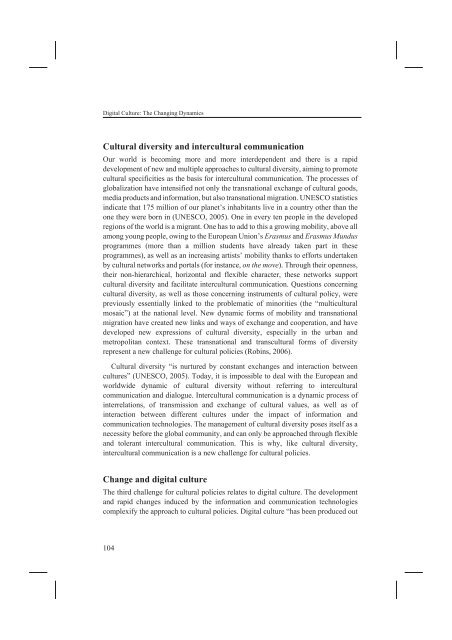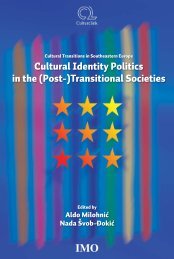D:\Documents and Settings\Ana\My Documents\Biserka-knjiga ...
D:\Documents and Settings\Ana\My Documents\Biserka-knjiga ...
D:\Documents and Settings\Ana\My Documents\Biserka-knjiga ...
Create successful ePaper yourself
Turn your PDF publications into a flip-book with our unique Google optimized e-Paper software.
Digital Culture: The Changing Dynamics<br />
Cultural diversity <strong>and</strong> intercultural communication<br />
Our world is becoming more <strong>and</strong> more interdependent <strong>and</strong> there is a rapid<br />
development of new <strong>and</strong> multiple approaches to cultural diversity, aiming to promote<br />
cultural specificities as the basis for intercultural communication. The processes of<br />
globalization have intensified not only the transnational exchange of cultural goods,<br />
media products <strong>and</strong> information, but also transnational migration. UNESCO statistics<br />
indicate that 175 million of our planet’s inhabitants live in a country other than the<br />
one they were born in (UNESCO, 2005). One in every ten people in the developed<br />
regions of the world is a migrant. One has to add to this a growing mobility, above all<br />
among young people, owing to the European Union’s Erasmus <strong>and</strong> Erasmus Mundus<br />
programmes (more than a million students have already taken part in these<br />
programmes), as well as an increasing artists’ mobility thanks to efforts undertaken<br />
by cultural networks <strong>and</strong> portals (for instance, on the move). Through their openness,<br />
their non-hierarchical, horizontal <strong>and</strong> flexible character, these networks support<br />
cultural diversity <strong>and</strong> facilitate intercultural communication. Questions concerning<br />
cultural diversity, as well as those concerning instruments of cultural policy, were<br />
previously essentially linked to the problematic of minorities (the “multicultural<br />
mosaic”) at the national level. New dynamic forms of mobility <strong>and</strong> transnational<br />
migration have created new links <strong>and</strong> ways of exchange <strong>and</strong> cooperation, <strong>and</strong> have<br />
developed new expressions of cultural diversity, especially in the urban <strong>and</strong><br />
metropolitan context. These transnational <strong>and</strong> transcultural forms of diversity<br />
represent a new challenge for cultural policies (Robins, 2006).<br />
Cultural diversity “is nurtured by constant exchanges <strong>and</strong> interaction between<br />
cultures” (UNESCO, 2005). Today, it is impossible to deal with the European <strong>and</strong><br />
worldwide dynamic of cultural diversity without referring to intercultural<br />
communication <strong>and</strong> dialogue. Intercultural communication is a dynamic process of<br />
interrelations, of transmission <strong>and</strong> exchange of cultural values, as well as of<br />
interaction between different cultures under the impact of information <strong>and</strong><br />
communication technologies. The management of cultural diversity poses itself as a<br />
necessity before the global community, <strong>and</strong> can only be approached through flexible<br />
<strong>and</strong> tolerant intercultural communication. This is why, like cultural diversity,<br />
intercultural communication is a new challenge for cultural policies.<br />
Change <strong>and</strong> digital culture<br />
The third challenge for cultural policies relates to digital culture. The development<br />
<strong>and</strong> rapid changes induced by the information <strong>and</strong> communication technologies<br />
complexify the approach to cultural policies. Digital culture “has been produced out<br />
104



